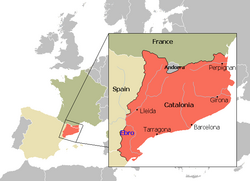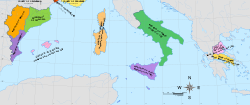
Back Prencipau de Catalunya AN إمارة كتالونيا Arabic Principáu de Cataluña AST কাতালোনিয়া রাজ্য Bengali/Bangla Priñselezh Katalonia Breton Principat de Catalunya Catalan Katalánské knížectví Czech Tywysogaeth Catalwnia Welsh Fyrstendømmet Catalonien Danish Fürstentum Katalonien German
Principality of Catalonia | |
|---|---|
| 12th century–1714/1833 | |
 Territory of the Principality of Catalonia until 1659. Location superimposed to current borders | |
 Location of the Principality of Catalonia (light green, at the left) within the Crown of Aragon | |
| Status |
|
| Capital | Barcelona |
| Common languages |
|
| Religion |
|
| Government | Monarchy subject to constitutions |
| Count[1] | |
• 1164–1196 | Alfons I (first) |
• 1706–1714 | Charles III (last) |
| President of the Deputation | |
• 1359–1362 | Berenguer de Cruïlles (first) |
• 1713–1714 | Josep de Vilamala (last) |
| Legislature | Catalan Courts |
| Historical era | |
• Reign of Alfons I | 1164–1196 |
• First legal definition of Catalonia | 1173 |
• First Catalan constitutions | 1283 |
| 1359 | |
• Reign of Charles I | 1516–1556 |
| 1659 | |
| 1701–1714 | |
| Population | |
• 1700 | c. 500,000 |
| Currency | Croat, Ducat, Florin, Peseta, and others |
| Today part of | |
The Principality of Catalonia (Catalan: Principat de Catalunya; Occitan: Principat de Catalonha; Spanish: Principado de Cataluña; Latin: Principatus Cathaloniæ) was a medieval and early modern state[2][3][4][5][6] in the northeastern Iberian Peninsula. During most of its history it was in dynastic union with the Kingdom of Aragon, constituting together the Crown of Aragon. Between the 13th and the 18th centuries, it was bordered by the Kingdom of Aragon to the west, the Kingdom of Valencia to the south, the Kingdom of France and the feudal lordship of Andorra to the north and by the Mediterranean Sea to the east. The term Principality of Catalonia was official until the 1830s, when the Spanish government implemented the centralized provincial division, but remained in popular and informal contexts. Today, the term Principat (Principality) is used primarily to refer to the autonomous community of Catalonia in Spain, as distinct from the other Catalan Countries,[7][8] and usually including the historical region of Roussillon in Southern France.
The first reference to Catalonia and the Catalans appears in the Liber maiolichinus de gestis Pisanorum illustribus, a Pisan chronicle (written between 1117 and 1125) of the conquest of Majorca by a joint force of Northern Italians, Catalans, and Occitans.[9] At the time, Catalonia did not yet exist as a political entity, though the use of this term seems to acknowledge Catalonia as a cultural or geographical entity. The counties that eventually made up the Principality of Catalonia were gradually unified under the rule of the count of Barcelona. In 1137, the County of Barcelona and the Kingdom of Aragon were unified under a single dynasty, creating what modern historians call the Crown of Aragon; however, Aragon and Catalonia retained their own political structure and legal traditions, developing separate political communities along the next centuries. Under Alfons I the Troubador (reigned 1164–1196), Catalonia was regarded as a legal entity for the first time in 1173.[10] Still, the term Principality of Catalonia was not used legally until the 14th century, when it was applied to the territories ruled by the Courts of Catalonia.
Its institutional system evolved over the centuries, establishing political bodies analogous to the ones of the other kingdoms of the Crown (such as the Courts, the Generalitat or the Consell de Cent) and legislation (constitutions, derived from the Usages of Barcelona) which largely limited the royal power and secured the political model of pactism.[clarification needed] Catalonia contributed to further develop the Crown trade and military, most significantly their navy. The Catalan language flourished and expanded as more territories were added to the Crown, including Valencia, the Balearic Islands, Sardinia, Sicily, Naples, and Athens, constituting a thalassocracy across the Mediterranean. The crisis of the 14th century, the end of the rule of House of Barcelona (1410) and a civil war (1462–1472) weakened the role of the Principality in Crown and international affairs.
The marriage of Ferdinand II of Aragon and Isabella I of Castile in 1469 laid the foundations of the monarchy of Spain. In 1492 the Spanish colonization of the Americas began, and political power began to shift away towards Castile. Tensions between Catalan institutions and the monarchy, alongside the peasants' revolts, provoked the Reapers' War (1640–1659), who saw the brief establishment of a Catalan Republic. By the Treaty of the Pyrenees (1659) the Roussillon was ceded to France. During the War of the Spanish Succession (1701–1714), the Crown of Aragon supported the Archduke Charles of Habsburg. After the surrender of Barcelona in 1714, King Philip V of Bourbon, inspired by the French model, imposed absolutism and a unifying administration across Spain, and enacted the Nueva Planta decrees for every realm of the Crown of Aragon, which suppressed the main Catalan, Aragonese, Valencian and Majorcan political institutions and rights and merged them into the Crown of Castile as provinces, ending their status as separate political entities. However, the territories, including the Principality of Catalonia, remained as administrative units until the establishment of the Spanish provincial division of 1833, which divided Catalonia into four provinces.
- ^ Sabaté 1997, p. 341
- ^ Ryder, Alan (2007). The Wreck of Catalonia. Civil War in the Fifteenth Century. Oxford University Press. p. v. ISBN 978-0-19-920736-7.
This group of states comprised the kingdoms of Aragon, Valencia, and Majorca, the principality of Catalonia, and the counties of Roussillon and Cerdagne; further afield it embraced the kingdoms of Sicily and Sardinia. These states had no common institutions or bonds save allegiance to a common sovereign
- ^ Chandler, Cullen J. (2019). Carolingian Catalonia: Politics, Culture, and Identity in an Imperial Province, 778–987. Oxford University Press. p. 22.
The region is only unique in its later statehood and conjunction with the kingdom of Aragon in the high Middle Ages, while other former Carolingian territories were eventually reabsorbed by the French crown.
- ^ Ferro 1987, p. 442
- ^ Eliott 1963, p. 4.
- ^ Sesma 2000, p. 14
- ^ Conversi, Daniele (2014). "Modernity, globalization and nationalism: the age of frenzied boundary-building". In Jackson, Jennifer; Molokotos-Liederman, Lina (eds.). Nationalism, Ethnicity and Boundaries: Conceptualising and Understanding Identity Through Boundary Approaches. Routledge. p. 65. ISBN 978-1317600008. Archived from the original on 14 January 2023. Retrieved 17 June 2017.
- ^ Conversi, Daniele (2000). The Basques, the Catalans and Spain: Alternative Routes to Nationalist Mobilisation. University of Nevada Press. p. xv. ISBN 0874173620. Retrieved 3 January 2017.[permanent dead link]
- ^ "Latin text of the Liber maiolichinus with Spanish introduction" (PDF). Archived from the original (PDF) on 2007-09-29.
- ^ Sesma 2000, p. 62.